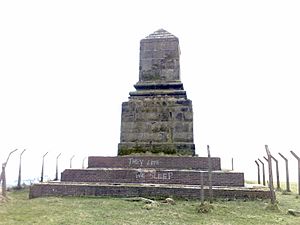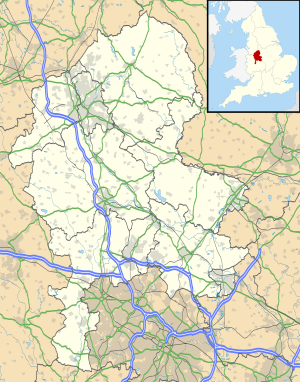Bignall Hill facts for kids
Quick facts for kids Bignall Hill |
|
|---|---|

Wedgwood Monument on Bignall Hill
|
|
| Location | Staffordshire, England |
| OS grid | SJ820512 |
| Coordinates | 53°03′30″N 2°16′10″W / 53.058357°N 2.269469°W |
Bignall Hill in Staffordshire, England, is a well-known local landmark. It is part of a ridge that stretches about 4 miles northwest of Newcastle-under-Lyme. Bignall Hill is known as a "HuMP," which means it's a hill over 100 meters high with a certain prominence.
The Wedgwood Monument
At the very top of Bignall Hill, you'll find a large stone monument. This monument honors John Wedgwood (1760–1839). He was an important local businessman and owned a coal mine in the area.
The monument was first built in 1850. It was an obelisk, which is a tall, narrow, four-sided pillar. In 1976, a big storm damaged it. After the storm, it was made much smaller, about a quarter of its original size. However, its base is still very large. This monument is now a Grade II listed building, meaning it's an important historical structure.
You can reach the monument by following footpaths. It's the highest point in the area. From the top, you get amazing 360-degree views!
Amazing Views
From Bignall Hill, you can see far and wide in every direction.
- To the south, you can spot Cannock Chase and the city of Stoke-on-Trent.
- Looking north, you'll see across the Cheshire Plains to the Jodrell Bank radio telescope.
- To the east, you can see Mow Cop Castle and the beautiful Peak District.
- And to the west, on a clear day, you might even see the mountains of North Wales and Snowdonia.
Where is Bignall Hill?
Bignall Hill is located in the parish of Audley Rural. Around the bottom of the hill, there are a few small villages and areas. These include Bignall End, Red Street, and Waterhays.
A Look Back in Time
Bignall Hill has a long and interesting history.
- Ancient Discoveries: A Bronze Age dagger was found on the hill. This suggests that people might have used the hill a very long time ago, possibly as an early hill fort for protection.
- Roman Connections: A major Roman road passed very close to the hill. It was only about one mile away, near the area known as Red Street.
- Coal Mining History: Below the hill are the remains of a coal mine. This mine was once owned by the Wedgwood family. Today, this area has become a nature reserve. It's also a Historic Site of Biological Interest Grade 2. This means it's an important place for nature and history. Workers at the colliery sometimes went on strikes, especially during the First World War.


